2018 Equipment Restoration and Renewal Grant awardees announced
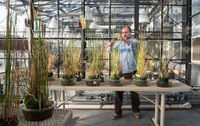
Notre Dame Research has provided six researchers or research groups from three Colleges and Schools with awards from the Equipment and Restoration Renewal (ERR) grant program for 2018. The ERR grant program was created to assist in the restoration, replacement, and renewal of the facilities needed for faculty research at the University of Notre Dame.
Two College of Science professors in Michiana's 2018 "Forty under 40" class
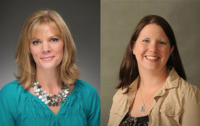
A blend of dedication to the community and a joyful work ethic landed two science professors in the spotlight as they were inducted into the 2018 Michiana Forty under 40 class. The inductees from the College of Science were Nancy Michael, assistant teaching professor and director of undergraduate studies, Neuroscience and Behavior; and Jenifer Prosperi, adjunct assistant professor in the Department of Biological Sciences at Notre Dame and member of Harper Cancer Research Institute, as well as assistant professor of biochemistry and molecular biology, Indiana University School of Medicine–South Bend. A third inductee from Notre Dame was Regan Jones, the University’s director for military and veterans affairs.
Dengue virus transmission dominated by those with undetected infection, study finds

People showing virtually no symptoms are likely the primary source of dengue fever, according to new research published in PLOS Pathogens. Nearly 400 million people each year are infected with dengue virus, which is transmitted through mosquitoes. The study estimates that more than 80 percent of dengue virus infections are attributable to individuals with mild to no symptoms who do not seek treatment from a physician. The study also indicates that nearly a quarter of dengue virus transmission is the result of mosquitoes biting those already infected before the onset of symptoms. By the time those symptoms appear, the opportunity to prevent the virus from spreading has passed.
Winners Declared in 2018 3MT® College of Science Qualifying Round

Cool temps did nothing to chill the heated competition among College of Science Shaheen 3MT competitors Tuesday night at Jordan Hall of Science. Sara Lum (Chemistry), Whitney Liske (Math), and Elvin Morales (Biology) took the top three spots, and will go on to compete at the 3MT® Finals event on April 23 in Jordan Auditorium, Mendoza College of Business. There they will face finalists from the College of Engineering and the College of Arts and Letters.
Faculty awards honor undergraduate teaching and advising
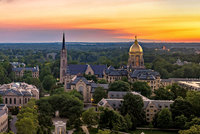
Twenty University faculty members have received Rev. Edmund P. Joyce, C.S.C., Awards for Excellence in Undergraduate Teaching, and three have been honored with Dockweiler Awards for Excellence in Undergraduate Advising.
University of Notre Dame researcher receives Indiana CTSI postdoctoral award
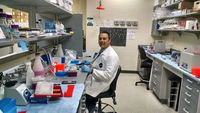
Henry Clay Conner, University of Notre Dame postdoctoral scholar, has received a Postdoctoral Training Award in Translational Research from the Indiana Clinical and Translational Sciences Institute (CTSI). The award will be used for his work in Athanasia Panopoulos’s lab.
Biological Sciences graduate student selected to attend National Graduate Student Symposium at St. Jude Children’s Research Hospital
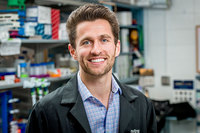
Every spring, St. Jude Children’s Research Hospital hosts the National Graduate Student Symposium (NGSS). The Symposium is held for the nation’s top Ph.D. students to present their work and learn more about St. Jude’s advanced research and facilities, which is located in Memphis, Tenn. This year, among more than 1500 applicants who had to be invited to apply, only 41 were selected. Notre Dame biology graduate student Mark Hawk is among this year’s attendees.
Natural bacterial proteins may prove viable alternatives to antibiotics
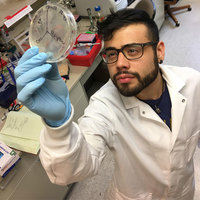
Tiny proteins found in the genomes of some types of bacteria are effective weapons against a wide range of other bacteria, opening the door for the development of new therapies in the age of antibiotic resistance, according to new research at the University of Notre Dame.
Theology, ethics and…salmon? Unlikely trio finds unity in Laudato si’
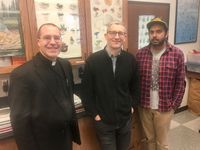
Notre Dame research by Dominic Chaloner, Bharat Ranganathan, and Fr. Terrence Ehrman, C.S.C. sought to explore the principles of integral ecology set forth in Pope Francis’ 2015 encyclical Laudato si’- "On Care For Our Common Home."
Women lead: Progress is made in the details outside the frame

On the occasion of International Women's Day 2018, meet seven scholars whose work is inspiring others to #PressForProgress.
Mapping the burden of cholera in sub-Saharan Africa
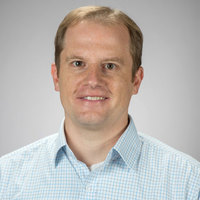
Sean Moore, a research assistant professor in the Department of Biological Sciences and the Eck Institute for Global Health, has coauthored a paper mapping the incidence of cholera in Africa, a critical step in the World Health Organization’s goal of reducing cholera deaths by 90 percent over the next decade. “Mapping the burden of cholera in sub-Saharan Africa and implications for control: an analysis of data across geographical scales” appeared in The Lancet on March 1, 2018. The mapping enables targeted application of cholera elimination strategies to high-incidence areas for most immediate and effective control. Reports often aggregate cases for a whole country and do not identify high-incidence areas within the country.
As climate changes, so could the genes of the Eastern tiger swallowtail butterfly
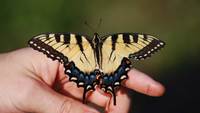
The reality of climate change poses a significant threat to global biodiversity. As temperatures rise, the survival of individual species will ultimately depend on their ability to adapt to changes in habitat and their interactions with other species. A new study published in the Proceedings of the National Academy of Sciences examines movement of the Eastern (Papilio glaucus) and Canadian (Papilio Canadensis) tiger swallowtail butterfly over a 32-year period within the geographic region where the two species mate, called the hybrid zone. The findings highlight the impact of changing climates and provide critical information for the protection and management of biodiversity.
Researchers discover novel mechanism linking changes in mitochondria to cancer cell death
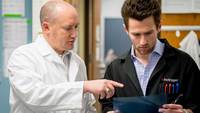
To stop the spread of cancer, cancer cells must die. Unfortunately, many types of cancer cells seem to use innate mechanisms that block cancer cell death, therefore allowing the cancer to metastasize. While seeking to further understand cancer cell death, researchers at the University of Notre Dame discovered that the activation of a specific enzyme may help suppress the spread of tumors. The findings, published in Nature Cell Biology, demonstrate that the enzyme RIPK1 decreases the number of mitochondria in a cell. This loss of mitochondria leads to oxidative stress that can potentially kill cancer cells, though researchers speculate the cancer cells could find ways to shut down this effect.
Theology and science faculty to speak at Vatican conference on Laudato si’
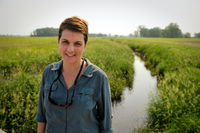
Two University of Notre Dame faculty members will participate in a Vatican conference titled “Radical Ecological Conversion after Laudato si’: Discovering the Intrinsic Value of All Creatures, Human and Non-human.” Sponsored by the embassies of Georgia, Germany and the Netherlands to the Holy See, this gathering will be held at the Pontifical Gregorian University in Rome March 7-8. Cardinal Peter Turkson, prefect of the Dicastery for Promoting Integral Human Development, will deliver the opening address.
Notre Dame among top producers of Fulbright students for fourth straight year

Twenty-nine University of Notre Dame students and alumni were awarded Fulbright U.S. Student Program grants during the 2017-18 academic year, second among all research institutions in the U.S., according to the U.S. Department of State’s Bureau of Educational and Cultural Affairs. Established in 1964, The Fulbright Program is the U.S. government’s flagship international educational exchange program, providing more than 380,000 students with the opportunity to exchange ideas and contribute to solutions to shared international concerns based on academic merit and leadership potential.
Notre Dame Research announces 2018 Internal Grant Program recipients
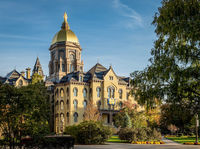
Twenty faculty members from five of the colleges and schools have been awarded grants through the Notre Dame Research Internal Grant Program (IGP). Recipients who applied were awarded Faculty Research Support Regular Grants, Faculty Research Support Initiation Grants, Rapid Response Grants, and other internal funding.
In Memoriam: Professor Emeritus Morton S. Fuchs

Morton S. Fuchs, professor emeritus in the Department of Biological Sciences at the University of Notre Dame, died Dec. 31 in Surprise, Arizona, after a long illness. His career at Notre Dame spanned more than four decades and his influence can still be felt in the department. From 1981 to 1984, Fuchs served as chair of the Department of Microbiology and in 1984 he accepted additional responsibilities as chair of the Department of Biology. The following year, Fuchs was instrumental in guiding the merger of the two departments into one, unified Department of Biological Sciences. In 2001, Fuchs earned emeritus status.
Events to mark Martin Luther King Jr. Day, Walk the Walk Week

In honor of Martin Luther King Jr. Day, the University of Notre Dame will host “Walk the Walk Week,” a weeklong celebration of King and his legacy, from Jan. 15 to 22, with events including a prayer service, lectures, film screenings and a celebration luncheon.
Growing Beauty: Tree survey marks 175 years of natural beauty at Notre Dame
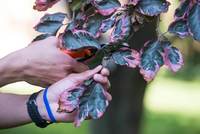
After trekking through the biting South Bend cold on Nov. 26, 1842, Rev. Edward Sorin, C.S.C., first laid eyes on the 524 acres bequeathed to the Congregation of Holy Cross to build a Catholic university, admired its two lakes and surrounding forest, and started planning his ideal landscape. He may have encountered a young sycamore tree that grows behind what is now Corby Hall. Currently one of the largest trees the University of Notre Dame’s campus, it is 80 feet tall and has thick, finger-like limbs that curl toward heaven in apparent angst. And certainly Father Sorin appreciated the ash trees, oaks, hickories and maples that surrounded St. Mary’s and St. Joseph’s lakes. But taming this “savage wilderness,” as one newspaper account in 1844 described the property, was necessary in order to create the pedestrian-friendly, academic utopia Father Sorin envisioned.
Little Giants: A closer look at a tiny bug with a big role to play

Michael Pfrender sits facing a whiteboard in his lab at the Galvin Life Science Center. He’s discussing the genomics of Daphnia – water fleas, found in every standing body of water in the world – and has a tendency to sketch when he speaks. “You want to see some of them?” he asks. “That’s the fun part, right?” At the back of the lab, two beakers sit on a table near a microscope. There isn’t much to see at first glance. Even leaning in, Daphnia are so small they look like bouncing flecks in the water, frantically trying to keep afloat.